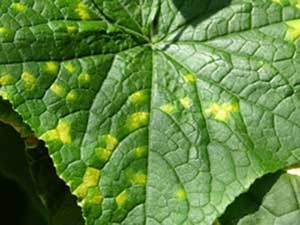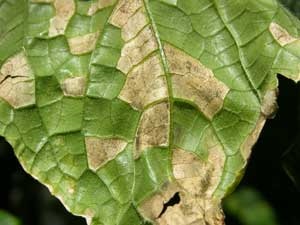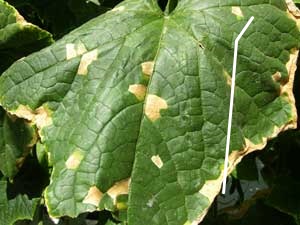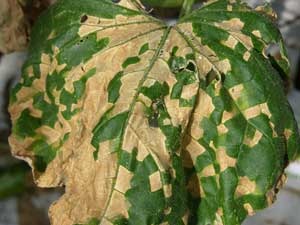Downy mildew of greenhouse cucumber
Information on symptoms, disease cycle, and management strategies for controlling downy mildew in greenhouse cucumbers.
Downy mildew is a disease caused by the fungus-like water mould, Pseudoperonospora cubensis, which attacks only cucumbers and related crop species (gourds, squash, pumpkin, melons). This disease primarily affects foliage and can cause severe yield losses in a short period of time.
Symptoms
Symptoms are usually seen first on the lower, older leaves. Initial symptoms of downy mildew typically consist of angular, yellow spots on the upper leaf surfaces (Figure 1).
On the undersides of such spots, a purplish-grey fungal growth may be visible when there is high relative humidity or moist conditions prevail (Figure 2).
As the disease progresses, the yellow spots enlarge and become necrotic or brownish in the centre, with the browning spreading to the margins of the spots (Figure 3).
Such spots may merge to form large brown areas on the leaves (Figure 4).
Diseased leaves are killed in this manner, if the disease is allowed to develop unchecked. Lack of photosynthetic tissue results in stunting of plants, reduced fruit size and poor fruit set.
Disease cycle
Pseudoperonospora cubensis is an obligate parasite requiring living host tissue to survive. It does not live in debris in the soil, and there are no reports of overwintering of the fungus in canada. Occasionally, under optimum environmental conditions, the pathogen may develop thick-walled spores called oospores that are resistant to low temperatures and dry conditions. This is rare and not considered an important source of inoculum. Infections in greenhouses likely originate from another type of spore (sporangia) that enters the facilities from the outside. Local field infections are usually established by spores carried by moist air currents blowing northwards from distant warmer regions where the fungus can overwinter on plant material.
Moisture on the leaf surfaces is necessary for infection to occur. When spores land on a wet leaf surface, they can either germinate and infect through the breathing pores (stomates) on leaves or release many smaller spores, called zoospores, that swim in the film of water on leaves during humid or wet conditions, and enter and infect leaves through stomates. Optimum temperatures for infection range between 16°C and 22°C, with infection occurring more rapidly at the warmer temperatures. The periods of wetness needed for infection on cucumber leaves are about 12 hours at 10°C–15°C, 6 hours at 15°C–19°C, and 2 hours at 20°C. About 4–5 days after infection, new spores are produced and released into the air, primarily in the morning. Spores can quickly spread within the greenhouse via moist air currents, contaminated tools, equipment, fingers and clothing. Fortunately, the spores become less infective under conditions of high temperatures and low humidity in the greenhouse.
Management strategies
Cultural practices
Manage the greenhouse environment
Avoid dew formation by providing adequate heating and ventilation. This is critical to reducing the conditions for infection and disease development. Pay special attention to purging moist air out of the greenhouses during the evenings and keeping the plant foliage dry, particularly during the night. At normal greenhouse temperatures, maintain a maximum of 70%–75% relative humidity (approximately 6.5–7.5 mbar or 0.65–0.75 kpa).
Sanitize
Remove all sources of infection, such as infected leaves and plants, and discard them, in garbage bags, away from the site. Disposal can include burial of plant debris, but ensure plants are buried properly so that spores do not escape and infect nearby commercial cucurbit fields (pumpkin, zucchini, cucumber, squash). Remove all weeds, including all cucurbit plants surrounding the greenhouse, because these may serve as reservoirs for the downy mildew fungus and for plant viruses. Disinfect surfaces in infested greenhouses.
Aerate the canopy adequately
Ensure that plants are sufficiently spaced and that the canopy is well pruned and thinned to provide for adequate air circulation.
Avoid over-watering
Over-watering not only leads to overly soft, more vulnerable plants, but also to production of droplets of moisture at the margins of leaves (guttation) early in the morning that provide perfect infection sites for the downy mildew pathogen.
Avoid overhead watering or humidification
Any cultural practice (for example, misting) that increases surface leaf moisture will increase disease development when downy mildew spores are present in the air.
Fungicides
See OMAFRA publication 836, Growing Greenhouse Vegetables in Ontario, for currently registered products. Supplements to this publication can be found on the OMAFRA website at Ontario.ca/crops.
Apply fungicides early
If only a few spots are evident on a few leaves of one plant, the disease is in the early stages of development. Implement appropriate control procedures immediately, because the spores are readily dispersed by air currents, and further disease development may be very rapid under favourable environmental conditions. Ensure good coverage, particularly with protectant fungicides.
Rotate products
Where possible, rotate fungicides to reduce the chances of developing resistance in the fungus to the material applied. Generally, use systemic fungicides in combination with protectant fungicides. As for all crop protection chemicals, always read and follow label recommendations.
Resources
- Agrios, George N. 2005. Plant Pathology. 5th ed. pp. 427-433.
- Blancard, D., H. Lecoq and M. Pitrat. 2005. A Colour Atlas of Cucurbit Diseases: Observations, Identification and Control. 3rd ed.
- Menzies, J.G., and W.R. Jarvis. 1994. In Diseases and Pests of Vegetable Crops in Canada. Eds. R.J. Howard, J.A. Garland, and W.L. Seaman. p. 308.
- University of Illinois Extension. April 2001. Downy Mildew of Cucurbits. Department of Crop Sciences, Report on Plant Disease. RPD No. 927.



